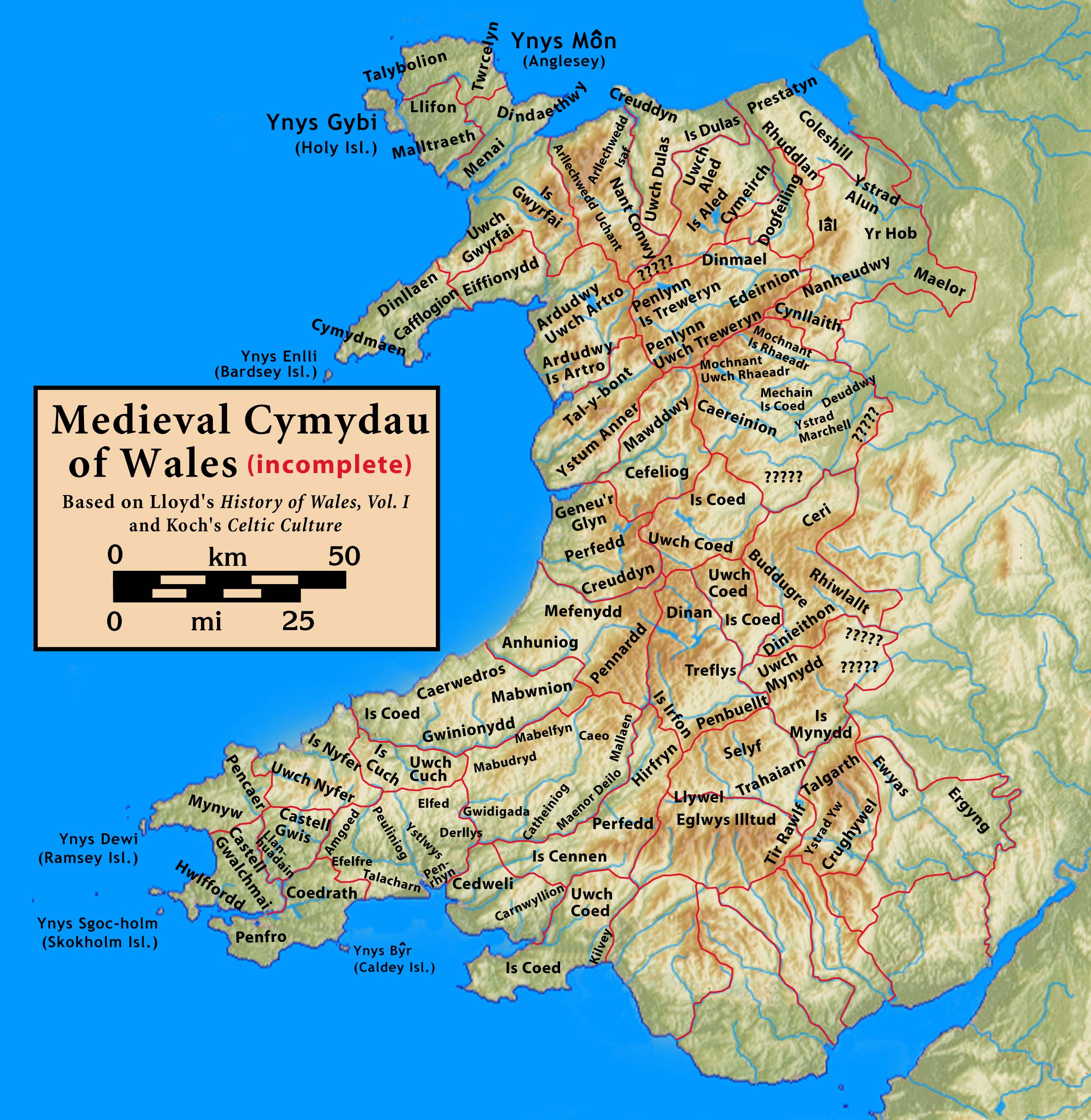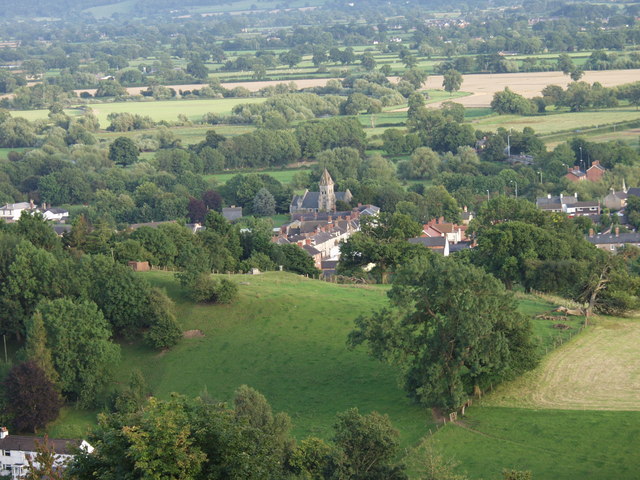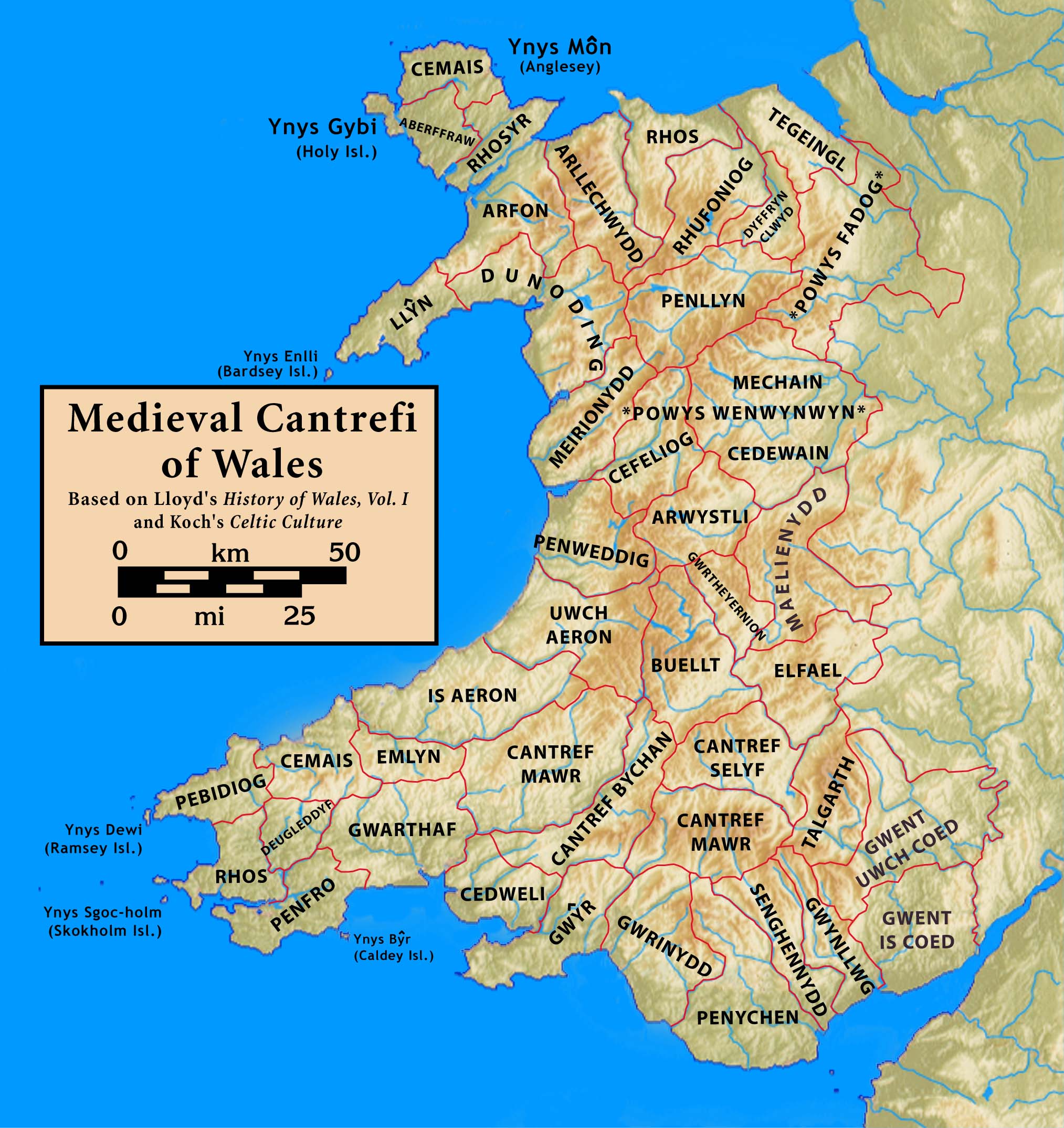|
Mochnant
Mochnant, a name translating as "the rapid stream", was a medieval cantref in the Kingdom of Powys. In the 12th century it was divided into the commotes of Mochnant Is Rhaeadr (in the north) and Mochnant Uwch Rhaeadr (in the south) (''Is'' signifying 'below' and ''Uwch'' 'above' the River Rhaeadr). Its north-west border was with the cantref of Penllyn, originally in Powys but which became annexed to the Kingdom of Gwynedd during the time of Owain Brogyntyn. It bordered the cantrefi of Caereinion and Mechain to the south, and Maelor to the north-east. The administrative centre was Llanrhaeadr-ym-Mochnant in Mochnant Is Rhaeadr. After the death of Madog ap Maredudd and his eldest son and heir in 1160, the kingdom was divided up between his surviving sons Gruffydd Maelor, Owain Fychan and Owain Brogyntyn, his nephew Owain Cyfeiliog and his half-brother Iorwerth Goch. Mochnant was initially given to Iorwerth Goch, but in 1166 he was ejected by Owain Cyfeiliog and Owain Fych ... [...More Info...] [...Related Items...] OR: [Wikipedia] [Google] [Baidu] |
Llanrhaeadr-ym-Mochnant
Llanrhaeadr-ym-Mochnant () is a village, community and an ecclesiastical parish in the extreme north of Powys, Wales; about 9 miles west of Oswestry and 12 miles south of Llangollen, on the B4580. It lies near the foothills of the Berwyn mountains on the river Rhaeadr. At the top end of the valley is the Pistyll Rhaeadr waterfall, one of the Seven Wonders of Wales in the old rhyme. One mile north of the town is the hill Moel Hen-fache (515 m). The community includes the hamlet of Llanarmon Mynydd Mawr. It was an important site in the ancient commote (or cantref; sources disagree) of Mochnant, as indicated by the ''ym-Mochnant'' in its name (translates to "in Mochnant"). Until 1974, Llanrhaeadr-ym-Mochnant was split into two civil parishes: the northern parish was in historic Denbighshire and the southern parish in historic Montgomeryshire; this reflected the division of the ancient commote in the 12th century. The divide continued between 1974 and 1996, with the former Denbighs ... [...More Info...] [...Related Items...] OR: [Wikipedia] [Google] [Baidu] |
Kingdom Of Powys
The Kingdom of Powys ( cy, Teyrnas Powys; la, Regnum Poysiae) was a Welsh successor state, petty kingdom and principality that emerged during the Middle Ages following the end of Roman rule in Britain. It very roughly covered the northern two-thirds of the modern county of Powys and part of today's English West Midlands (see map). More precisely, and based on the Romano-British tribal lands of the Ordovices in the west and the Cornovii in the east, its boundaries originally extended from the Cambrian Mountains in the west to include the modern West Midlands region of England in the east. The fertile river valleys of the Severn and Tern are found here, and this region is referred to in later Welsh literature as "the Paradise of Powys" (an epithet retained in Welsh for the modern UK county). Name The name Powys is thought to derive from Latin ''pagus'' 'the countryside' and ''pagenses'' 'dwellers in the countryside', also the origins of French "pays" and English "peasant". ... [...More Info...] [...Related Items...] OR: [Wikipedia] [Google] [Baidu] |
Powys Fadog
Powys Fadog (English: ''Lower Powys'' or ''Madog's Powys'') was the northern portion of the former princely realm of Powys, which split in two following the death of Madog ap Maredudd in 1160. The realm was divided under Welsh law, with Madog's nephew Owain Cyfeiliog inheriting the south (see Powys Wenwynwyn) and his son Gruffydd Maelor I, who inherited the north. Gruffydd received the cantref of Maelor and the commote of Iâl as his portion and later added Nanheudwy, Cynllaith, Glyndyfrdwy and Mochnant Is Rhaeadr. This northern realm became known as Powys Fadog after the accession of his son Madog ap Gruffudd in 1191 who reigned until 1236, and after whom it may be named (see alternative translations above). During his reign, Madog initially adopted a neutral position between Gwynedd and England but by 1215 had settled on an alliance with Llywelyn ab Iorwerth of Gwynedd. This policy of alliance with Gwynedd altered under his successor Gruffudd II over his thirty-three ye ... [...More Info...] [...Related Items...] OR: [Wikipedia] [Google] [Baidu] |
Owain Fychan
Owain Fychan ap Madog (alternatively ''Owain Vychan ap Madoc'') (c. 1125 – 1187) was styled Lord of Mechain Is Coed and one of the sons of Madog ap Maredudd. His mother was Susanna, daughter of Gruffudd ap Cynan. Division of the Kingdom of Powys His eldest brother, Llywelyn, was killed soon after the death of his father in 1160, at which point Powys was shared between Madog's sons Gruffydd Maelor, Owain Fychan and Owain Brogyntyn, his nephew Owain Cyfeiliog and half-brother Iorwerth Goch. Owain Fychan shared the southern portion of his father's territories with Owain Cyfeiliog. Working together they drove the English out of Carreghofa in 1163 (capturing and destroying the royal castle there, which was made of timber until fortified in stone in 1194) and Iorwerth Goch from Mochnant Is Rhaeadr in 1166. Owain Fychan now controlled Mechain, Cynllaith, Caereinion and Mochnant Is Rhaeadr. Carreghofa Castle was retaken by Henry II in 1165, but Owain Fychan recaptured it again ... [...More Info...] [...Related Items...] OR: [Wikipedia] [Google] [Baidu] |
Commotes
A commote (Welsh ''cwmwd'', sometimes spelt in older documents as ''cymwd'', plural ''cymydau'', less frequently ''cymydoedd'')'' Geiriadur Prifysgol Cymru'' (University of Wales Dictionary), p. 643 was a secular division of land in Medieval Wales. The word derives from the prefix ''cym-'' ("together", "with") and the noun ''bod'' ("home, abode"). The English word "commote" is derived from the Middle Welsh ''cymwt''. Medieval Welsh land organisation The basic unit of land was the ''tref'', a small village or settlement. In theory, 100 ''trefi'' made up a ''cantref'' (literally, "one hundred settlements"; plural: ''cantrefi''), and half or a third of a ''cantref'' was a ''cymwd'', although in practice the actual numbers varied greatly. Together with the ''cantrefi'', commotes were the geographical divisions through which defence and justice were organised. In charge of a commote would be a chieftain probably related to the ruling Prince of the Kingdom. His court would have been ... [...More Info...] [...Related Items...] OR: [Wikipedia] [Google] [Baidu] |
River Rhaeadr
The River Rhaeadr ( cy, Afon Rhaeadr) is a river in Wales. It starts at the Pistyll Rhaeadr waterfall a few miles from the village of Llanrhaeadr-ym-Mochnant, where the Afon Disgynfa falls over a 240-foot (73 m) cliff-face, after which the river is known as the Afon Rhaeadr. Downstream, the Afon Rhaeadr runs into the Afon Tanat. See also * River Wye The River Wye (; cy, Afon Gwy ) is the fourth-longest river in the UK, stretching some from its source on Plynlimon in mid Wales to the Severn estuary. For much of its length the river forms part of the border between England and Wales ... ( Afon Gwy) External links Photos of the River Rhaeadr on geograph.org.uk Rhaedr 2Rhaeadr {{Wales-river-stub ... [...More Info...] [...Related Items...] OR: [Wikipedia] [Google] [Baidu] |
Caereinion
Caereinion (fort of Einion) was a medieval cantref in the Kingdom of Powys, or possibly it was a commote (''cwmwd'') within a cantref called Llŷs Wynaf. It was divided into the manors of Uwch Coed and Is Coed. It lay towards the south of the kingdom, bordering with the commote of Mochnant Uwch Rhaeadr of the cantref of Mochnant and the cantref of Mechain to the north, the commotes of Ystrad Marchell and Llanerch Hudol in the cantref of Ystlyg to the east, the cantrefi of Cedewain to the south and Cyfeiliog to the west. It roughly corresponds to the later hundred of Mathrafal. Castle Caereinion, Caereinion Fechan, Llanfair Caereinion, Llanerfyl Llanerfyl is a village and community in Montgomeryshire, Powys, Wales. Located near the River Banwy, the community includes the village of Llanerfyl, several farms and wide tracts of marchland. The southern part of the community includes Cwm Nant ..., Llangadfan, Llangyniew and part of Berriew are within the territory of t ... [...More Info...] [...Related Items...] OR: [Wikipedia] [Google] [Baidu] |
Powys Wenwynwyn
Powys Wenwynwyn or Powys Cyfeiliog was a Welsh kingdom which existed during the high Middle Ages. The realm was the southern portion of the former princely state of Powys which split following the death of Madog ap Maredudd of Powys in 1160: the northern portion (Maelor) went to Gruffydd Maelor and eventually became known as Powys Fadog; while the southern portion (Cyfeiliog) going to Owain Cyfeiliog and becoming known, eventually, as Powys Wenwynwyn after Prince Gwenwynwyn ab Owain, its second ruler. Powys Wenwynwyn and Gwynedd became bitter rivals in the years that followed, with the former frequently allying itself with England to further its own aims of weakening the latter. Princes of Powys Wenwynwyn * 1160–1195 Owain Cyfeiliog married a daughter of Owain Gwynedd and abdicated in 1195. * 1195–1216 Gwenwynwyn ab Owain Gwenwynwyn seized the cantref of Arwystli in 1197, when he was aligned with England. Following the marriage of Llywelyn the Great and Joan of Engla ... [...More Info...] [...Related Items...] OR: [Wikipedia] [Google] [Baidu] |
Cantref
A cantref ( ; ; plural cantrefi or cantrefs; also rendered as ''cantred'') was a medieval Welsh land division, particularly important in the administration of Welsh law. Description Land in medieval Wales was divided into ''cantrefi'', which were themselves divided into smaller ''cymydau'' (commotes). The word ''cantref'' is derived from ''cant'' ("a hundred") and ''tref'' ("town" in modern Welsh, but formerly used for much smaller settlements). The ''cantref'' is thought to be the original unit, with the commotes being a later division. ''Cantrefi'' could vary considerably in size: most were divided into two or three commotes, but the largest, the ''Cantref Mawr'' (or "Great Cantref") in Ystrad Tywi (now in Carmarthenshire) was divided into seven commotes. History The antiquity of the ''cantrefi'' is demonstrated by the fact that they often mark the boundary between dialects. Some were originally kingdoms in their own right; others may have been artificial units created later ... [...More Info...] [...Related Items...] OR: [Wikipedia] [Google] [Baidu] |
Gruffydd Maelor
Gruffydd Maelor (died 1191) was Prince of Powys Fadog in Wales. He is known as Gruffydd Maelor I to distinguish him from his grandson, Gruffydd Maelor II (died 1269). Lineage He was a son of Prince Madog ap Maredudd by Susanna, daughter of King Gruffudd ap Cynan. He was to be the founder of the principal ruling family of northern Powys during the 13th century. Inheritance On his father's death in 1160 Powys was divided between his three sons (Gruffydd, Owain Brogyntyn and Owain Fychan), a nephew ( Owain Cyfeiliog) and a half-brother ( Iorwerth Goch ap Maredudd). Gruffydd received Maelor (also known as Bromfield) and Iâl (also known as Yale), as his allotted portion of Powys. He later added Nanheudwy, Cynllaith Owain and Mochnant Is Rhaeadr after the death of his half-brother Owain Fychan in 1187. Unification of northern Powys His inherited and acquired lands in effect unified and reunited most of northern Powys forming what became known as Powys Fadog after it was ... [...More Info...] [...Related Items...] OR: [Wikipedia] [Google] [Baidu] |
Mechain
Mechain was a medieval cantref in the Kingdom of Powys. This cantref has also been referred to as Y Fyrnwy (''Vyrnwy''). Mechain may owe its name to the River Cain which flows through it on its way to join the River Vyrnwy; 'Me' or 'Mach' (c.f. Machynlleth, Mathrafal, etc., and in modern Welsh, field is ''maes'') may signify meadows or plain, in which case Mechain would mean "Meadows of the Cain". It corresponds to the later hundred of Llanfyllin. Mechain lay almost in the centre of the kingdom, bordering with the cantref of Caereinion to the south, the two commotes of the cantref of Mochnant to the north, and the commotes of Deuddwr and Ystrad Marchell in the cantref of Ystlyg to the east. It consisted of the commotes (''cymydau'') of Mechain Uwch Coed (''Mechain above the wood'') and Mechain Is Coed (''Mechain below the wood'') separated by the large wood or forest which stretched across the cantref around Bwlch-y-cibau. The caput of Mechain Uwch Coed was at Tomen yr Allt () ... [...More Info...] [...Related Items...] OR: [Wikipedia] [Google] [Baidu] |






